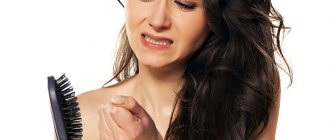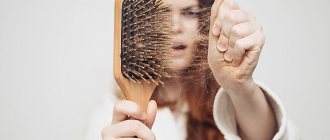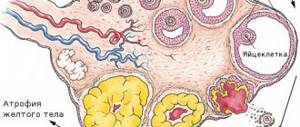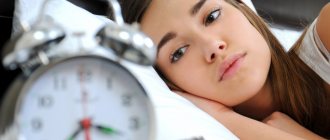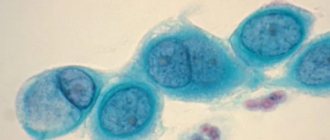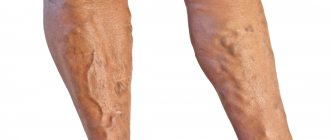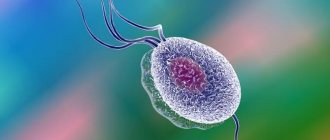Causes of hirsutism in women
Among the main reasons for the appearance of hirsutism in girls are:
- the presence of a genetic predisposition. In this case, the constitutional form of the disease develops. It arises due to the large number of hair follicles initially located at the genetic level;
- climacteric condition. After the completion of menstrual function, the ovaries cease to perform their main function of producing estrogen. As a result, androgens (groups of steroidal male sex hormones) accumulate in the body, which do not turn into estrogens;
- pathology of the ovaries. Among the pathologies that affect the ovaries, we should highlight diseases that have different causes and mechanisms of action, but have the same clinical manifestations in the form of hirsutism. Among the most common pathologies are: cystic changes in the ovaries;
- benign or malignant neoplasms (arrhenoblastomas, adrenal tumors, masculinizing tumors and luteomas);
- Itsenko-Cushing syndrome;
- streptomycin;
Reasons for rejection
Increased hair growth according to the male type is always caused by an increase in the concentration of androgens (male sex hormones) in the blood and tissues of a woman - only the reasons for such an increase are distinguished. Therefore, according to the types of development, all causes of hirsutism can be divided into the following groups:
- Hyperandrogenemia and subsequent hirsutism caused by pathologies of the endocrine system. In fact, this is one of the most common mechanisms for increasing hair growth on the face and other areas in women. These pathologies include polycystic ovary syndrome, Itsenko-Cushing syndrome or disease, tumors that produce testosterone and other androgens, and disorders of the adrenal glands (adrenogenital syndrome). All these diseases lead to the fact that the concentration of female sex hormones in the blood decreases and the concentration of male hormones increases.
- Side effects from taking certain medications, especially hormonal ones. The thing is that the treatment of some diseases of the endocrine system may require the use of drugs that are similar in structure to androgens. In other cases, certain medications (antibiotics, hormonal and other drugs) can stimulate the formation of testosterone and its metabolites in the body. In both cases, the woman will have an increase in the concentration of male sex hormones, which, in turn, will stimulate hair growth, that is, hirsutism.
- Familial forms of hirsutism, sometimes also called genetic, are observed in members of the same family and can be inherited from mother to daughters. But this group of causes for the development of the disorder can be divided into two parts - firstly, there are endocrine pathologies (polycystic ovary syndrome, adrenogenital syndrome) that are inherited and lead, among other things, to hirsutism. Secondly, there is the so-called constitutional hirsutism, which is determined by the peculiarities of a woman’s nationality - this kind of manifestation is especially common in the nationalities of the Mediterranean, Caucasian and Middle Eastern regions.
- Hirsutism caused by hormonal imbalances due to age or post-pregnancy conditions. This group of causes is very close in nature to damage to the organs of the endocrine system, however, only a pronounced hormonal imbalance is observed, which does not particularly affect the endocrine glands themselves.
Whatever the cause of this disorder, for most women it causes great concern - especially when hair growth is accompanied by changes in voice timbre, menstrual irregularities and other symptoms. Therefore, this condition requires a thorough examination to determine the causes, and then comprehensive treatment.
Symptoms
The main complaint with which people seek medical help is male-pattern hair growth in women. Instead of light vellus hair, a more rigid structure and increased pigmentation are formed. Typical places for growth are areas in the face, areola of the mammary gland, abdomen, inner thighs, buttocks (see photo above).
Hair greasiness increases. On the part of the skin, an increase in sebum production begins to worry; alopecia and acne appear in typical areas of hair growth. Hirsutism in girls begins to appear during puberty.
Signs of hyperandrogenism such as virilization gradually appear (photo below). There is an appearance of male outlines, this is an increase in muscle mass, baldness in the temple area, a decrease in the size of the mammary glands, and a predominant deposition of fat in the area of the anterior abdominal wall. The voice gradually becomes rougher.
Virilization
The genitals begin to change:
- there is a reduction in the labia;
- increase in the size of the clitoris;
- the appearance of severe dryness on the vaginal mucosa.
A typical manifestation of hirsutism is menstrual dysfunction . Delays gradually appear until they stop completely. Discharge may be scanty with occasional breakthrough bleeding. Severe pain appears in the groin areas and during sexual intercourse, associated with an increase in the size of the ovaries. Women of reproductive age develop infertility , which may be irreversible.
Hirsutism in children is a rare manifestation.
Male pattern hair growth: treatment
Taking into account the reasons that cause male pattern hair, treatment involves reducing the level of androgens and insulin. Therefore, before treatment it is necessary to be examined.
For polycystic ovary syndrome, in which male hair growth is noted, oral contraceptives, aldalactone, and clomiphene are prescribed. You can reduce the production of androgens by the ovaries by using a combination of birth control pills, which contain estrogen and progesterone in a certain dose. Male hair growth in women disappears after 10-12 months of taking contraceptives. Of course, hormonal treatment should be prescribed and monitored by a doctor.
For congenital adrenal hyperplasia, which is accompanied by increased production of androgens, cortisol is prescribed. Losing weight also reduces androgen levels.
Types and stages of the disease
To assess the degree of hair growth, a special visual rating scale is used, which is used to determine the sum of the points obtained. Based on their sum, the degree of development of hirsutism is determined. For hirsutism:
- from 1 to 7 degree of hair growth is considered normal;
- from 8 to 9 degree is the border between normal and excessive;
- from 12 the patient is diagnosed with hirsutism.
Clinical types of hirsutism:
- neuroendocrine;
- dermatological;
- Iatrogenic.
Types of association of the disease with other symptoms:
- hirsutism itself;
- hirsutism with a clinical picture of aggravated hyperactive piloseborrheic complex (acne, acne);
- hirsutism and ovulation disorders;
- hirsutism and virilization.
HIRSUTISM: CAUSES OF EXCESSIVE HAIR GROWTH IN WOMEN AND GIRLS
Excess hair on a woman's face and/or body not only spoils her appearance, but is often a symptom of a serious disorder. There are several main causes of hirsutism.
- Genetics
Heredity plays an important role, and hirsutism often becomes a “family disease” that is inherited.
- Ethnicity
Women of Middle Eastern, South Asian and Mediterranean origin are most likely to suffer from increased hairiness. This condition can be considered normal.
- Hyperandrogenism
High levels of male hormones (androgens) lead not only to male pattern baldness, but also to hirsutism.
- Polycystic ovary syndrome
PCOS occurs when there is an imbalance of hormones in a woman's body and causes the formation of cysts in the ovaries, as well as other symptoms.
- Cushing's syndrome
A disorder in which the production of the stress hormone cortisol increases, which affects the entire hormonal balance of a woman.
- Tumors
Neoplasms of the ovaries, adrenal glands or brain disrupt the proper production of hormones and can lead to polycystic disease, hyperprolactinemia and other endocrine disorders.
- Medicines
Taking certain medications affects hair growth and can provoke symptoms of hirsutism. Such medications include hormones, anabolic steroids, drugs for the treatment of endometriosis, Minoxidil (which can lead to hypertrichosis), and hormonal allergy medications.
- Sensitivity
In some women, the hair follicles on the skin of the body are overly sensitive to even normal levels of male hormones. This provokes increased hairiness without any hormonal disturbances. When is hirsutism diagnosed?
To find out the cause of increased hair growth, you need to consult an endocrinologist or gynecologist-endocrinologist. He will prescribe an ultrasound of the thyroid gland and ovaries, blood tests for insulin, testosterone and other sex hormones. The specialist will also conduct an external visual examination and assessment using the Ferriman-Gallwey scale.
Sometimes a woman cannot be diagnosed with any health problems. In this case, the cause of excessive hair growth on the body and face remains unclear, and the condition itself is classified as idiopathic hirsutism.
Is it possible to prevent or avoid the development of hirsutism?
There is no prevention. You cannot change genetics and congenital predisposition. If hirsutism is caused by heredity, it cannot be cured. However, you can try to avoid certain conditions that lead to increased hair growth in women (such as obesity and insulin resistance), and not unnecessarily take medications that lead to increased hair growth.
Diagnostics
Identification begins with a conversation between the doctor and the patient. The complaints, the time of their occurrence and their probable cause are clarified.
Of great importance in diagnosis is the nature of the menstrual cycle, its regularity, time of establishment, the presence of pregnancy and childbirth, because this is a condition that quickly affects the reproductive system.
An assessment of the appearance is carried out, identifying areas of excess hair growth and its intensity.
Help the doctor more accurately assess the state of hair development; for this, several weeks before the visit you should not use hair removal methods. In addition, you should pay attention to other secondary sexual characteristics.
The fundamental methods for making diagnoses are laboratory and instrumental diagnostics. It is carried out for all women with identified hirsutism.
Of the laboratory methods, which are very diverse, for this pathology we can limit ourselves to:
- blood test for total testosterone levels . Normally, its concentration should be in the range from 0.24 to 2.7 nmol/l. If the concentration increases, a tumor process in the ovaries should be excluded, and if the concentration decreases, take medications from the group of combined contraceptives or prednisolone.
- dehydroepiandrosterone sulfate . One of the metabolites of androgen metabolism, the concentration of which should be in the range from 2700 to 11000 nmol/l. An increased amount indicates excessive secretion of the substance in the adrenal cortex. In addition, this may be a tumor process in the adrenal cortex or long-term treatment with drugs such as dexamethasone.
- androstenedione assessment . Its concentration normally ranges from 75 to 205 n/dl. An increase may be a manifestation of ovarian pathology.
- determination of 17-hydroxyprogesterone . An increase in level above 8.7 zero/l is due to adrenal hyperplasia.
- cortisol study . If the level of the indicator does not go beyond 138-635 nmol/l, this indicates the possible presence of Itsenko-Cushing syndrome.
- assessment of gonadotropins . Great importance is paid to the relationship between the levels of luteinizing and follicle-stimulating hormones. Its ratio should not be more than 2.5.
These hormones are essential for not only identifying the disease, but also determining how to treat hirsutism.
Additional tests may also be prescribed depending on the presence of concomitant pathology.
Instrumental diagnostic methods include:
- ultrasound examination , which examines the ovaries and adrenal glands. The method is widely used due to its non-invasiveness and special training. If a Doppler unit is available, the degree of blood flow must be assessed;
- in the event that there is a suspicion of pathology of the pituitary gland or hypothalamus, it is necessary to conduct an X-ray examination to assess the condition of the sella turcica ;
- , computed tomography may be used ;
- If a tumor process is detected, it is necessary to perform laparoscopy .
Treatment of hirsutism in women
Hirsutism can be treated using various methods. Among them, the most effective are medicinal and surgical. In the event that there is severe hirsutism, traditional methods may not be effective.
In women, treatment must be carried out especially quickly to avoid problems with reproductive function, which leads to infertility.
Drug treatment
Since medications form the basis of treatment for hirsutism, they should be aimed at eliminating the main cause that caused the pathological condition. Among them:
- Oral combination drugs . In addition to the minimum dosage of estrogens, there is an increase in the dosage of hormones that have an antiandrogenic effect. Temporary use may lead to a decrease in the severity of hirsutism. Thanks to treatment, spontaneous pregnancy may occur. These drugs include the following drugs: Zhannina;
- Diana—35;
- Jess plus.
- Prednisolone;
- Spironolactone;
Antiandrogen drugs for women for hirsutism are limited in use due to possible contraindications. They should not be neglected, as life-threatening conditions may arise.
Surgery
When tumors of both malignant and benign courses are detected, surgical treatment is indicated. It comes down to either complete removal of the organ along with the tumor (this is a necessary measure for a malignant process at any level), or partial resection. Partial tissue removal is indicated in cases where tumor cells are hormonally active. Complete removal of an organ can lead to a number of complications from other body systems, especially the pituitary gland or adrenal glands, so removing part of the hormonally active cells can compensate for the condition.
If the gland is completely removed, lifelong hormonal therapy may be prescribed.
Depilation
This is one of the treatment methods that helps a woman get rid of the psychological component of this disease. After removing unwanted hair, a woman shows inner confidence and depression decreases.
The methods listed below are only a temporary measure; there is no way to completely get rid of hair. Among the main methods are:
- photoepilation;
- laser removal;
- bioepilation;
- medicinal methods;
- shaving.
Female-type hair growth is not aggravated in this case.
Traditional methods of treating hirsutism
The use of traditional methods cannot always change hormone levels. In addition, the use of these funds can lead to complications in other organs and systems. But, herbal preparations can be used in local form, reducing cosmetic defects.
Among the most popular methods are:
- Juice of unripe walnuts . To prepare the product, you should cut the young fruits, after the juice appears on the cut, apply it to the area of excess hair. To achieve the effect, a single application per day is sufficient; the course of therapy lasts an average of 10 days. In the initial forms, one course is sufficient.
- Henbane . To prepare the decoction, you need to mix 150 mg of dry herb with a liter of purified water. The resulting mixture is boiled, evaporating the contents, until 200 ml of the finished decoction is obtained. This ensures the creation of effective concentration. While waiting for the solution to cool, it must be filtered. After which it is applied to the lesions where there is excess hair growth twice. The course of therapy lasts on average 5 days. Do not exceed the frequency of application due to possible poisoning.
- A mixture of lemon and sugar . One ripe lemon is squeezed out and the resulting juice is mixed with 3 tablespoons of sugar and 200 ml of water. The resulting mixture is simmered over low heat until it begins to thicken. After which the mixture is cooled and applied to the skin. After application, leave the mixture for 10 minutes. Subsequently, the skin is cleansed with warm water.
Traditional treatment will not completely eliminate male pattern hair in women.
Idiopathic hirsutism
Idiopathic hirsutism means that the cause of excess hair growth is not known. There are suggestions that this type of hirsutism may be inherited (genetically determined), as in some cases there is a family history of this condition. Apart from excess hair growth, women with this type of hirsutism do not exhibit any other abnormalities in the functioning of the body.
In general, hirsutism refers to excess male pattern hair growth in women (facial, chest and abdominal hair). Research shows that between 5% and 15% of women suffer from excess hair growth. All women have a certain amount of male sex hormones in their blood. If the level of male sex hormones is elevated or if the sensitivity of the hair follicles to androgens is initially increased, the woman will be bothered by excess hair growth.
The Ferriman-Gallway hirsut number may be an objective indicator of idiopathic hirsutism.
Idiopathic hirsutism
In most cases, idiopathic hirsutism manifests itself during puberty with excessive hair growth (hypertrichosis and/or hirsutism). Idiopathic hirsutism often runs in families. In most cases, women have regular menstrual cycles with ovulation.
Sometimes these women have obesity and/or insulin resistance. Most women with idiopathic hirsutism have normal androgen levels in the blood. In such cases, the main cause of hypertrichosis and/or hirsutism is increased sensitivity of the skin to androgens, caused by increased activity of 5 alpha reductase in the hair follicles.
It is known that among some ethnic groups, for example, among residents of the Mediterranean and some regions of Asia, hirsutism, which is hereditary, is common. In such women, the amount of male sex hormones is normal, but the sensitivity of the receptors in the hair follicles to androgens is increased.
Idiopathic hirsutism - symptoms
| Ferryman-Gallway score | High Ferriman-Gallway score Excessive growth of terminal hair in androgen-dependent areas of the body (face, chest, abdomen). |
| Menstrual cycle | Regular menstrual cycle Hormonal and ultrasound tests show normal ovulation and normal hormonal changes throughout the menstrual cycle. |
| Male hormones (androgens) | Normal Androgen Levels Hormonal tests show normal levels of all types of androgens in the blood and urine. |
| Leather | Increased sensitivity of the skin to androgens (hereditary) Experts believe that there is a possibility of genetic modification of the function of the receptors and increase their sensitivity to androgens |
Idiopathic hirsutism - treatment
| Laser hair removal | Modern methods of removing unwanted hair in women |
Removal of unwanted hair in idiopathic hirsutism is usually carried out using modern cosmetic methods including waxing, electrolysis, plucking and laser hair removal. Explore the latest hair removal methods on the next page.
Relevant links from Women's Information/Google
Complications
Since the disease is often endocrine in nature, i.e. its appearance is associated with disruption of the endocrine glands. With a long course and lack of treatment, type 2 diabetes mellitus occurs, this will be caused by tissue insulin resistance.
In women of reproductive age and adolescents, hirsut syndrome left untreated poses the greatest danger, causing polycystic ovary syndrome. Long-term polycystic disease leads to depletion of the supply of follicles, which subsequently causes infertility.
Also, cycle irregularity manifests itself in the development of difficult-to-stop uterine bleeding or long-term delays in menstruation with dysfunctional uterine bleeding.
Prevention
For the hereditary form of hirsutism, there are no specific preventive measures. For neurogenic causes, if the first manifestations are detected, it is necessary to seek help from specialists and promptly eliminate or correct the cause of this pathology.
When prescribing medications that can lead to the appearance of a symptom such as excess hair growth, it is therefore necessary to consult with your doctor for the possible use of drugs aimed at preventing growth.
You should not attempt independent hair removal at the beginning of specific therapy. This can make the situation worse, causing more hair growth.
HIRSUTISM: SYMPTOMS
The main symptom of hirsutism in women is the growth of unwanted hair on the face, chest, and back. This thick, dark hair is different from the normal, fine hair that is normally found on any healthy woman's body.
Other signs of hirsutism may include:
- acne, pimples,
- menstrual irregularities,
- the girl has a rough voice,
- muscle or weight gain,
- reduction in breast size.
Forecast
Hirsute syndrome has a relatively favorable prognosis. There are no serious complications that could be a direct cause of mortality. Only the appearance of diabetes mellitus can significantly change the standard of living, due to the introduction of a diet and constant treatment.
A woman may experience significant problems associated with psychological discomfort. These include disruption of contact with the opposite sex, destruction of marriages, etc.
Treatment of hirsutism can be lengthy and does not always produce an initial effect. The minimum period required to achieve the effect is a year or six months. It should be understood that even properly selected therapy will not be able to relieve the patient from the problem of excess hair growth. It only slows down the growth of old ones and prevents the appearance of new foci of excess hair.
Cochrane
Relevance
About 5% - 10% of women have hirsutism - male pattern hair (hair grows in places that are usually found only in men: mustache, beard area, chest, abdomen, back, etc.). The most common cause of this is polycystic ovary syndrome. Hirsutism can lead to psychological distress, low self-esteem, low self-esteem, depression, shame and social difficulties.
Review Question
What treatments (excluding laser and light therapy alone) work best for hirsutism?
Characteristics of studies
We included 157 studies published up to June 2014, involving 10,550 people. Participants were women with a mean age of 25 years. There was significant variation in the quality of how the studies were conducted; more than half were unblinded, and this may have influenced the reporting of outcomes. Most studies were conducted at single centers in Europe and lasted between six and 12 months. A variety of treatment procedures have been assessed, mostly in single studies. These included some topical treatments, lifestyle modifications, oral contraceptives (OCs), medications to suppress the effects of male hormones, and combination therapy. Participant-rated improvement and impact on quality of life were examined in a minority of studies, while most studies measured physician-rated improvements in hirsutism as well as blood androgen levels. Half of the studies reported adverse events and about one third reported other signs and symptoms, such as oily skin and menstrual irregularities, which may be associated with increased blood androgen levels.
Main results
Oral contraceptive (OC) pills reduced hair count, but this reduction was not consistent across studies, although two OCs (ethinyl estradiol 35 mcg + cyproterone acetate 2 mg versus ethinyl estradiol 30 mcg + desogestrel 0.15 mg) appeared to be effective to the extent that it can be considered important for women with hirsutism.
Among the antiandrogens (drugs with anti-androgenic effects), flutamide has been rated by both women and doctors as more effective than placebo. Spironolactone was also effective, but data were only available on physician assessments. Finasteride did not show convincing effectiveness based on evaluations by both women and researchers. The addition of cyproterone acetate (an antiandrogen) to OCs appeared to enhance the hair reduction benefits of OCs.
Insulin sensitizers (antidiabetic drugs) and lifestyle changes had no apparent benefit in terms of the severity of hirsutism. Unfortunately, women's self-esteem, as well as the impact of hirsutism on their quality of life, were outcomes that were not sufficiently addressed in research.
There are well-known adverse events that have been reported across different medications, such as stomach and intestinal pain, breast tenderness, decreased libido, and dry skin, with flutamide and finasteride; irregular bleeding - when using spironolactone; nausea, diarrhea and bloating - when using metformin; and hot flashes, decreased libido, vaginal dryness, breast tenderness and headaches - when using gonadotropin-releasing hormone (GnRH) analogues.
There were no important differences in blood androgen levels between the different treatment groups; OCs had a positive effect on acne, and insulin sensitizers improved the regularity of the menstrual cycle.
We expected to find evidence that combining an OC with an antiandrogen would be more effective than, for example, an OC alone, but the lack of studies did not allow us to draw such conclusions.
Overall, we conclude that OCs (especially those with antiandrogenic activity), OCs in combination with cyproterone acetate, flutamide, and spironolactone are effective in the treatment of hirsutism. However, additional cosmetic measures (hair removal, waxing, bleaching, electrolysis, laser and photo hair removal) are usually required because at least six to 12 months are needed to achieve optimal results. In addition, because of the distress associated with hirsutism and its impact on quality of life, psychological support should be part of treatment.
Quality of evidence
Overall, the quality of the evidence for the various outcomes was rated on average as moderate to very low. Important reasons for this were that the studies were not blinded or had a small sample size.


